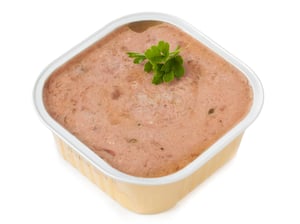Food can spoil for a variety of reasons, but one of the main causes is the growth of microbes such as bacteria, yeast and mold that feed and grow on the food product, causing the food to go bad and rendering it unsafe for consumption. One way that we rid food of these pesky bacteria in our own homes is by cooking the food. But for pre-packaged food products that are pre-cooked and ready for consumption, how can we stop the re-growth of these bacteria and microbes to ensure a safe product?
For shelf-stable applications, extending product shelf-life through a combination of packaging material sterilization systems and customized material structures that offer enhanced barrier protection, while providing unique packaging to support brand differentiation, is critical.
One example of a food packaging and processing method used to extend the shelf-life of food products is retort processing. Packaging developed for use in retort processing requires the use of sophisticated barrier materials to maintain product quality and meet shelf-life expectations. In addition, the rigorous conditions of retort process present unique challenges, such as the risk of "retort shock," requiring additional material considerations.
Continue reading to learn more about retort processing, common challenges, and how ICPG's material solutions can help.
What Is Retort Processing?
Retort sterilization and processing is the process in which a non-sterile food product, either raw or cooked, is filled into hermetically-sealed, non-sterile packaging. The packaging is then loaded into a retort pressure vessel and heated to extremely high temperatures ranging from 230-275° F for several minutes under high pressure. Through this process, the food is effectively cooked and both the food and packaging container are sterilized, resulting in food products that are ready for consumption. The process of retort sterilization provides safe, effective, shelf-life extension 16-24 months depending on supply chain and storage conditions.
 The benefit to this type of processing is the relatively low cost to process and sterilize food combinations. With the various processing techniques used in the food industry, retort processing enables large particulate products such as fruit, vegetables and proteins to be effectively processed and sterilized in the barrier plastic container while providing the desired long-term shelf life performance. Retort packaging in cans has been around for decades, and the performance enhancements now provided by rigid barrier plastic containers enables processors to provide enhanced shapes and end-use capabilities such as microwavable ready-to-heat and ready-to-eat meals.
The benefit to this type of processing is the relatively low cost to process and sterilize food combinations. With the various processing techniques used in the food industry, retort processing enables large particulate products such as fruit, vegetables and proteins to be effectively processed and sterilized in the barrier plastic container while providing the desired long-term shelf life performance. Retort packaging in cans has been around for decades, and the performance enhancements now provided by rigid barrier plastic containers enables processors to provide enhanced shapes and end-use capabilities such as microwavable ready-to-heat and ready-to-eat meals.
Common Applications for Retort Products
In addition to the retort sterilization process, choosing a material structure that provides a combination of oxygen and moisture barrier protection also helps to extend the shelf life and reduce food spoilage and waste.
Developing a rollstock structure that can meet key barrier requirements while reducing the risk of "retort shock" is key to enhanced packaging performance. Retort shock occurs when moisture permeates the material used on the outer layer of the rollstock, and reaches the encapsulated EVOH layer. When exposed to moisture, the EVOH loses its gas barrier properties, and can no longer effectively protect the sealed food product from oxygen permeation, eventually leading to food spoilage, waste, and loss for the producer. Thus, managing retort shock through multi-layer barrier structures is key for retort products.
ICPG material solutions compatible with retort processing and packaging can be customized to meet target extended shelf-life requirements with a custom multi-layer coextruded barrier rollstock structure. Structures using polypropylene materials are well-suited for applications that use retort processing because of their inherent moisture barrier and their ability to withstand high temperatures. ICPG's material solutions compatible with rigid plastic thermoformed containers for retort processing include symmetrical and asymmetrical multi-layer barrier coextruded structures using polypropylene and EVOH (PP/EVOH/PP). In addition, ICPG's innovative XPP™ Enhanced Barrier Polypropylene can offer enhanced moisture protection of up to 80% over traditional PP materials, to provide improved protection to the EVOH layer against the effects of retort shock.
Ready to get started developing a customized and enhanced material structure for your retort processing application? Download our XPP™ Enhanced Barrier Polypropylene product sheet today:




